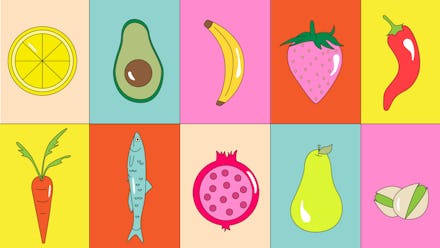Can the pegan diet actually make you hot and save the planet too?

Post pandemic re-entry is spawning a whole new glow up industry. Suddenly everyone is hiking, biking, dieting, “detoxing,” and botoxing. The pegan diet — a diet that combines elements of veganism and paleo eating — is making a strong comeback. Proponents claim that it can help you lose weight, gain lean muscle, and save the planet. Isn’t that what all diets claim, though? Here’s the skinny on whether the pegan diet is healthy or just more wellness hype.
What is the pegan diet?
First of all, the term “pegan” is coined by Mark Hyman, a doctor and nutritionist. Legend has it, two colleagues on a panel were arguing about whether eating vegan or eating paleo was healthier, and Hyman suggested combining the best of both worlds. Thus, “peganism” was born and with it a lot of books and products.
How exactly do you combine veganism and paleo, you might be wondering, since paleo basically entails a cave-person meat-abundant diet and vegan is, well, the opposite. Peganism, first off, involves eliminating processed food and replacing it with whole food, a strategy that both vegan and paleo diets share. Unlike veganism, though, which is often carb heavy, a pegan diet limits grains and restricts carbohydrate intake to whole grains that have a low glycemic index — like brown rice and quinoa. The intention here is to keep your sugar low, your protein high, and your belly full of veggies so that you can build lean muscle and stay lean.
Pegans, like many vegans and keto-dieters, eat a lot of high quality fats, like avocado and coconut oil, and they prioritize veggies. Unlike veganism, though, the pegan diet allows for ethically sourced meat and dairy, albeit in limited amounts. Full disclosure, this is basically how I eat, only I call it being vegan-ish and I honestly had no idea it was “a thing.”
Why is it a thing right now?
In this cultural moment, folks are really searching for ways to get fit fast, and peganism is #trending as a way to do that that is, well, kind of doable. “I think the pegan diet is overall less restrictive than the paleo or vegan diets,” says Kimberly Marsh, a Denver-based registered dietician. The lack of restrictions, Marsh says, make it more accessible to people, easier to follow, and more nutrient rich than other diet plans. “I appreciate the fact the diet focuses on eating a lot of plant foods,” agrees Julie Harris, a Maryland-based registered dietician. “I also appreciate peganism's emphasis on consuming enough protein, some whole grains, and nutrient-rich fats.” Basically, nutritionists agree that the strength of the pegan diet is its lack of restriction.
Peganism is healthier than some diets that cut out whole food groups and more accessible because it includes more variety, but it’s still restrictive and most pegans make eating organic a high priority, which is great, but also expensive. “Although, the diet is focused on healthy eating principles, it may be unsustainable or impractical for many people due to food costs of natural, organic foods,” she says. Harris agrees. “It could be quite expensive, as the diet focuses on organic, responsibly raised foods,” Harris says.
How will it change my lifestyle?
The pegan diet is considered eco-conscious because it encourages 3/4 of your nutritional intake to consist of fruits and vegetables — and the other 1/4 should be meat and fish that's responsibly sourced. Harris does point out that eating only sustainably-sourced low carb organic whole foods could make it kind hard to dine out — once we can responsibly do that again — and Harris doesn’t want us to forget the social aspect of eating. It’s important for us to break bread together, even if we haven’t done it for a while. And it’s harder to break bread when you don’t eat bread (and a bunch of other items found at most people's dinner tables).
The pegan diet also requires a lot of meal prep, which frankly, some of us who are lower on the socio-economic food chain just don’t have time for. For individuals in lower socio-economic status, peganism can be more costly — and time consuming — than sourcing from their local grocery vendor, says Harris. This is not no big deal. “Lack of accessibility is a major drawback,” she says. In case that feels confusing, what lack of accessibility means in practical terms is that only folks with a lot of privilege get to do it.
Rich people have always had different diets than us proles, though, right? Sure, but their fads and trends seep into the cultural pool we all swim in, and for some people, that can be actually dangerous. “The major drawback can be emotional,” says Harris. Trendy diets that focus on restrictions can create unhealthy relationships with food and body image, and I probably don’t need to explain why that’s a big deal. Basically, yes, peganism is a pretty healthy way to eat — if you can afford it. A less costly method is simply focusing on prioritizing food that's good for our body — and the planet. But the unrealistic food restrictions? That's just hype.